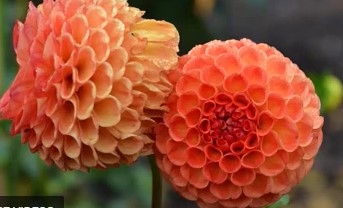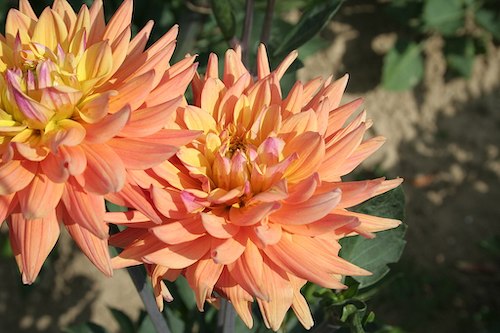Dahlia — Your Garden’s Late Summer Sweetheart
by Elizabeth Cornell Fake, Fairfax Master Gardener
 The Dahlia has captured the hearts and minds of gardeners for centuries. Originally cultivated by the Aztecs in Mexico for food and medicinal properties, the 16th century Spanish explorers carried the tubers home where they became well established throughout the gardens of Europe. Because of the many diverse and stunning varieties, their popularity spurred a phenomenon known as “Dahlia Mania” in the 19th century, and they were a particular favorite of Queen Victoria in her English gardens. Today’s gardeners are just as enamored and look forward to the late summer months when Dahlias bloom in great profusion all around.
The Dahlia has captured the hearts and minds of gardeners for centuries. Originally cultivated by the Aztecs in Mexico for food and medicinal properties, the 16th century Spanish explorers carried the tubers home where they became well established throughout the gardens of Europe. Because of the many diverse and stunning varieties, their popularity spurred a phenomenon known as “Dahlia Mania” in the 19th century, and they were a particular favorite of Queen Victoria in her English gardens. Today’s gardeners are just as enamored and look forward to the late summer months when Dahlias bloom in great profusion all around.
Named for the famous botanist, Anders Dahl, Dahlias belong to the Asteraceae family, with over 42 accepted species and thousands of cultivars in pink, red, orange, yellow, purple and combinations of colors. They are highly diverse and vary in size from multi-layered pie plate sized flowers to single layered blossoms and tiny pom poms.

Pom pom dahlia
Dahlias are tuberous roots that grow best in zones 8 to 10 where they can be planted one time and come back every year as perennials. In Fairfax, Virginia zone 7 gardens, where temperatures dip below 25 degrees in the winter, they must be treated as annuals, dug up every fall, sheltered in a garage or basement for the winter and then replanted in the spring.
Many say Dahlias are “high maintenance,” but enthusiasts disagree saying even a novice can grow them successfully. To begin, plant dahlias the same time you plant tomatoes. For best results, select healthy tubers from a plant nursery or order online from one of the local chapters of The American Dahlia Society. Look for tubers that are firm and without signs of disease or damage. Some gardeners recommend starting the tubers outside in small 4-to-5-inch pots (10 to 12 cm) in late April and then transferring them to the ground in mid to late May when there is no danger of frost.
Choose a sunny location that receives six to eight hours of light a day in well-drained soil. Prepare the soil with the addition of organic matter or compost to ensure robust growth. Plant tubers to a depth of 4 to 6 inches (10 to 15 cm) with the eye or growing point facing upwards. Space 18 to 24 inches (45 to 60 cm) apart to allow for adequate growth and air circulation. Depending on the variety, Dahlias can grow from 1 foot to 6 feet (0.3 to 2 m) tall, and 1 foot to 3 feet (0.3 to 1 m) wide. For the tall varieties, allow more space, with at least 2 to 3 feet between plants to provide sufficient space for growth. Plan to stake the tall varieties using 3-foot wooden stakes and place the stakes in the ground before planting the tubers to prevent piercing at a later stage. Tomato cages also work well to support the taller plants. Water regularly to keep the soil moist but avoid overhead watering to prevent fungal diseases.
In addition to the beauty and diversity of the different cultivars, Dahlias are perfect for pollinator gardens as they attract beneficial insects like butterflies and bees. They are drought resistant and can withstand the hot, humid Virginia summer with ease. They are prolific bloomers meaning the more blossoms you cut, the more flowers they produce from late July into the fall. Best of all, our local, hungry deer have no interest in or attraction to Dahlias and leave them alone.

Single dahlias
At the end of the growing season, be prepared to dig them up for storage in a cool dry place over the winter. Carefully lift them out of the soil, brush off excess dirt and ensure they are completely dry before storing them in plastic or cloth bags filled with sand or vermiculite. Replant in the spring as described above.
Dahlias are susceptible to a wide array of diseases and pests. Powdery Mildew is a common fungal disease that appears as a powdery white coating on the leaves, stems, and buds of the plant. It thrives in humid conditions and can threaten the plant by reducing photosynthesis. Follow spacing guidelines for planting and avoid overhead watering.
Botrytis Blight also known as gray mold, affects dahlias causing browning, wilting and decay. It is also caused by damp conditions and can spread quickly if plants are too close together or if there’s too much rain. Avoid overhead watering and provide adequate spacing between plants.
Dahlia Smut is a fungal disease that causes black, powdery spots on the leaves and stems resulting in distorted and stunted leaves and stems. Remove and destroy affected parts to prevent the spread of smut.
Aphids, leafhoppers, caterpillars, spider mites, slugs, snails, thrips, nematodes and viral diseases can also affect Dahlias. Be on the lookout for signs of stress and have some insecticidal soap handy to get ahead of suspected disease or pests.

Dalhia Karma ‘Corona’
The Karma Series features show stopping blooms that are 2 to 3 feet tall (0.5 to 1 m) and 8 inches (20 cm) in diameter. They are available is a wide array of bright colors and are favored for cut flowers. Single Dahlias are one of the most popular varieties for pollinator gardens with a single row of petals around a large flat center. They are a good choice to mix with other cutting flowers for summer bouquets. Bishop of Llandaff are a classic favorite, known for dark foliage and red flowers reminiscent of a Bishop’s cape. They are compact and bushy, disease resistant and recommended for beginners. The Mignon Series are compact and small, and ideal for containers. They bloom profusely throughout the summer and are available in red, pink and white. The Gallery Series produces petite and prolific blooms in an array of colors including yellow, orange, red, pink, purple and white. They are good for garden borders or mixed flower beds. Decorative Dahlias are a highly favored variety, with double blooms in various colors and patterns in soft colors. They can be used for garden focal points or mixed with other cutting flowers. Anemone Dahlias are unique with two layered blooms with tubular petals surrounded by a layer of flat petals. They are also available in a wide variety of bright summer colors.
Go ahead and try one or try them all to create a little Dahlia mania of your own!
Resources
The American Dahlia Society
Classification and Handbook of Dahlias, Online Classification Guide, The American Dahlia Society
Dahlia, North Carolina Extension Gardener Plant Toolbox